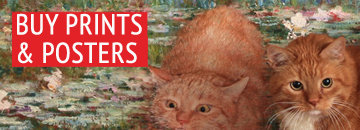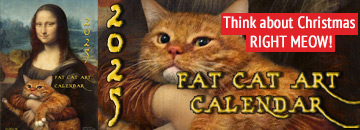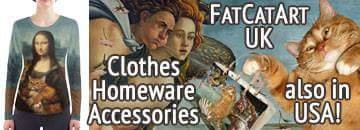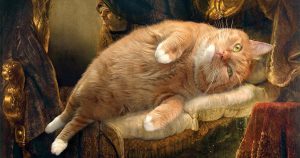The original Declaration of Independence revealed!
Breathtaking discovery! My dear friends, We are happy to reveal to the world the original version of John Trumbull’s “Declaration of Independence” that was found by gracious efforts of Us and Our beloved brother Hank. This painting depicts the moment on June 28, 1776, when the first draft of the Declaration of Independence was presented to the Second Continental Congress:
Less than a week later, on July 4, 1776, the colonial delegates signed the Declaration, a milestone in American history. As with all art, there is much symbolism to be found – We are holding John Adams’s hand, who wrote in regards to the Trumbull painting: “Do not let our posterity be deluded with fictions under the guise of poetical or graphical license.” Adams was concerned that this fictitious portrayal of history would lead Americans to believe this is how history happened – and of course, one of his concerns was the lack of cats in the painting. Thomas Jefferson gently strokes Hank’s ear – both are Virginians, and both believe deeply in their country during times of fear and mistrust of the government, that those in power can right our wrongs. Charles Thomson is seen tugging gently at Hank’s leg, trying to pull Hank into the fighting political arena (as Sec. of the Continental Congress, Thomson would often be involved in fights over what was said versus what was written). Benjamin Franklin is seen behind Hank, with a similar pose to Zarathustra – this represents how in post-Perestroika Russia, many people would hold onto their ‘franklins’ ($100 US) to have a stable currency to purchase goods. Finally, Hank is seen laying on the Declaration papers – as all cats know, the more important the papers, the better to lay on.
All these details are better seen at close up:
The commonly known version of the painting can be found at the Capitol Rotunda. The story of the versions is as follows: This is the first completed painting of four Revolutionary-era scenes that the U.S. Congress commissioned from John Trumbull in 1817 and purchased in 1819. It is an enlarged (365.76 cm ? 548.64 cm) version of a smaller painting (53 x 79 cm) that the artist had created in 1786 as part of a series to document the events of the American revolution.
Nobody knows and We and Hank revealed that it was another version created in 1818 between these two. The painting measuring 101 x 152 cm was created as a draft version to show it to Congress. It looked like that (close-up):
As the whole scene shows, many people had feathers to write because it was a working process over the document. Having in Our mind that We are a serious cat and it was a serious thread, We also took some feathers, and one feather was so huge that attracted the serious scientific attention of Our brother Hank (maybe you know that cats are fond of feathers in general). This epic moment of the work over the Declaration was depicted by John Trumball. But congressmen told him that it is much more cats story and not American history, so the painter remade the image presenting a more pathetic version where the cats are concentrated on the essence of the document and not on the tools to sign it (this official version is displayed at the beginning of our post). Trumbull was fully contented with his work, but the congressmen were not. The time went on, and the history became to turn into mythology, so they thought that Trumbull had some fantasies about cats’ presence. He really had some fantasies depicting people who were not there and not depicting persons who were present, it is true, but it was not in the case of two cats. Do you just imagine how any house could be managed without cats at that time? And what about struggling with rats?
But what to do, finally Trumbull obeyed the clients (sad artists’ destiny) and created the version without cats, which you can find now at the Capitol.
But the cats were in the Capitol in the past! The cat will be in Capitol in the future! Our beloved brother Hank the Cat should be a Senator!
Thus speaks Zarathustra the Cat




















